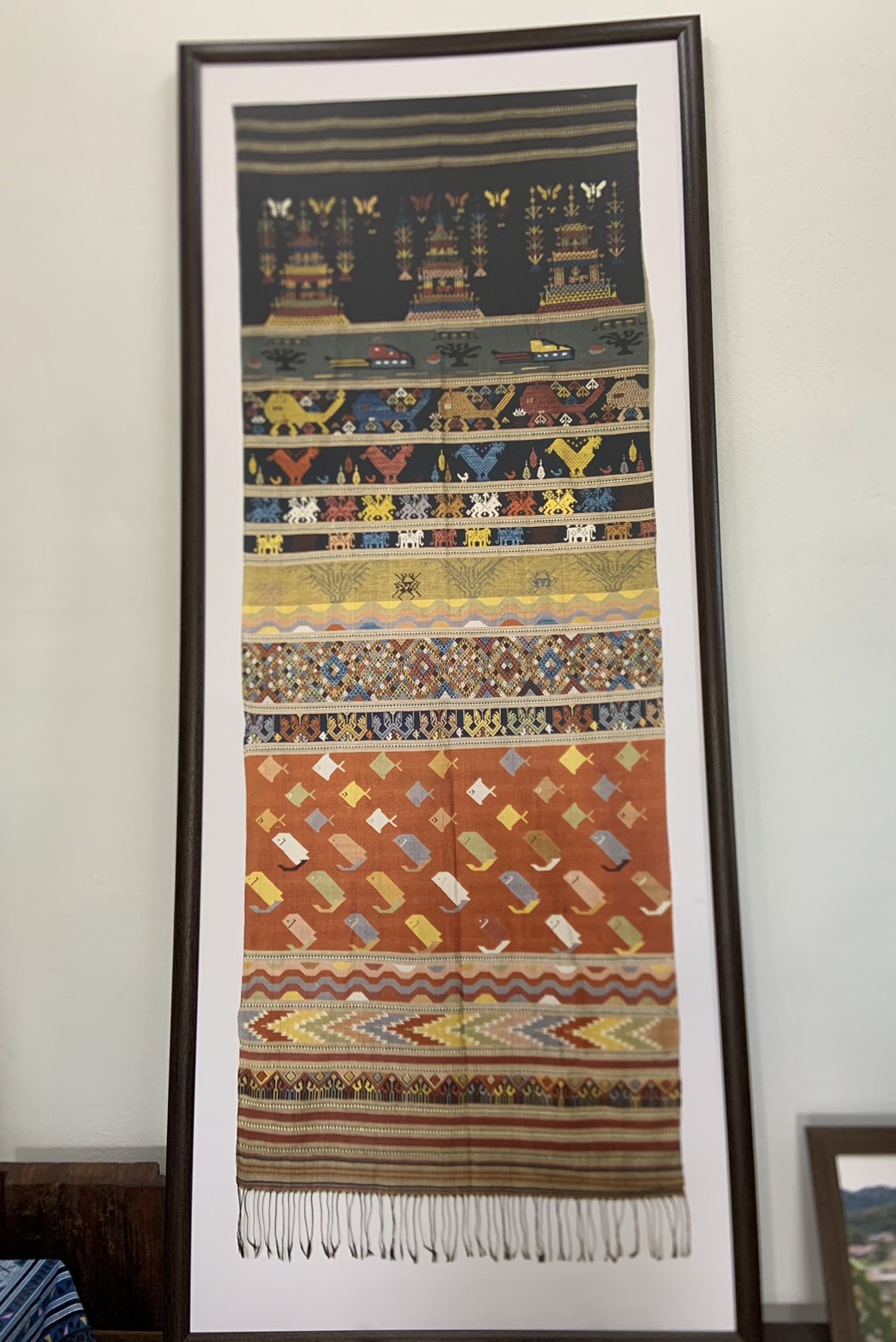
On the afternoon of December 9th, due to the agenda of Chiang Rai City of Arts and the Merit Faith for the Mekong River at the Mekong School Library. Opening of the Weaving of Life Cloth Show : Ecosin Tai Lue Woven Cloth, Haad Bai Haad Sai Thong. There were 14 people participating in the activity, including 5 students from Chiang Mai University, the Mekong School, and the Sukhawadee Woven Artist Group. Naturally dyed woven fabrics that tell the story of the history, ecology and Tai Lue culture of Baan Hat Bai Hat Sai Thong were brought out for display.
Before entering the launch of the Tai Lue woven fabric and the Lue’s Song. A video was shown of the fabric pattern, “Phleng Phaek: Weaving Life.” Later, Mother Sukhawadee Tiyatha told about the inspiration for coming together to weave a piece of cloth dyed with natural threads, telling the story of the Tai Lue people in the community. Natural abundance, rivers, changes that occur and the end of humanity

“Lai/pattern is a way of life. Clothes are used to make and stories arise from everyday life, leading to people coming together to create income until this cloth is created. This cloth is the cloth that creates the stories of the villagers. Let the cloth have meaning, which is the story of the villagers who are connected to their way of life regarding food and traditions. Therefore, this cloth has meaning… As it tells the story of the way of life from the past to the present.”
“The ‘Soi Sa’ pattern is in the shape of a bird or swan, which is an auspicious animal. Then it is a ‘water flow’ pattern or in the Tai Lue language it is called ‘Nam Hlai’ pattern. ‘Koh Yai -Fish Tail’ later became a water pattern. It is a way of life of finding shells, fish, and foods until now. It is about bringing the way of life into weaving so that the villagers know that We did not abandon our existing way of life. The fish here are rice field fish, white fish is all Mekong water fish, with the ‘Phayanak’ pattern. The Nagas is an auspicious animal that lives in deep water, cold water, and in water that is fertile. The ‘Kai/Chicken’ pattern in the past was while the villagers were weaving. There were chickens coming and bothering me. The chickens flew around and pecked at the cloth, so the pattern was woven into the cloth. The next one was a ‘water stream’ pattern that was rich in ‘rice plants’, ‘fish’ and ‘crabs’ that came from occupations in the community. Farming, rice farming, then something that people in the community respect is the ‘elephant’ and ‘horse’ pattern. In the past, elephants were used to carry things. and is a royal vehicle, a ‘helicopter’ pattern from the World War II era. There are ‘dams’ in the river, dry tree stumps floating in the river, and dead trees. (Sanglang trees) and fish began to disappear 30 years ago due to the construction of dams. The results obtained from the construction of the dam. The Mekong River fluctuates abnormally. It does not fluctuate according to the season, causing the fish to decrease. Finding fish is also more difficult because less fish are spawning. The islands began to disappear. Therefore causing difficulty in making a living. And the last pattern is the “Yod Prasat” pattern, which is the castle where angels live. It tells that whoever does good deeds will go to live in a castle with the angels when they die. But if anyone does evil, they will become a butterfly. Wandering around.”

After Mother Sukhawadee spoke about her inspiration and explained the meaning of the woven fabric. The villagers tell the story of the cloth through singing the Lue’s song. The Lue’s singing is the singing of songs that express the identity of the Tai Lue people. The Lue language will be used in singing. And while Lue’s song will say the words “Sei Sei Sei” which is a word of encouragement to Lue’s singer. Telling stories through fabric patterns and the weaving of cloth by the villagers of Hat Bai Hat Sai Thong, numbering more than 10 people and taking 91 days (3 months) for people in society to see the historical stories through woven cloth and Lue’s song and the Tai Lue woven cloth ecology of Hat Bai Hat Sai Thong has been selected to be exhibited at the Michigan State University Art Museum in the next two years.
This ecological art activity, Weaving Life Fabrics, is supported by both a workshop on designing woven fabric patterns. Weaving and materials from the Mekong Culture WELL project under the support of the Luce Foundation, Mae Fah Luang University and the Mekong School : Institute of Local Knowledge.



